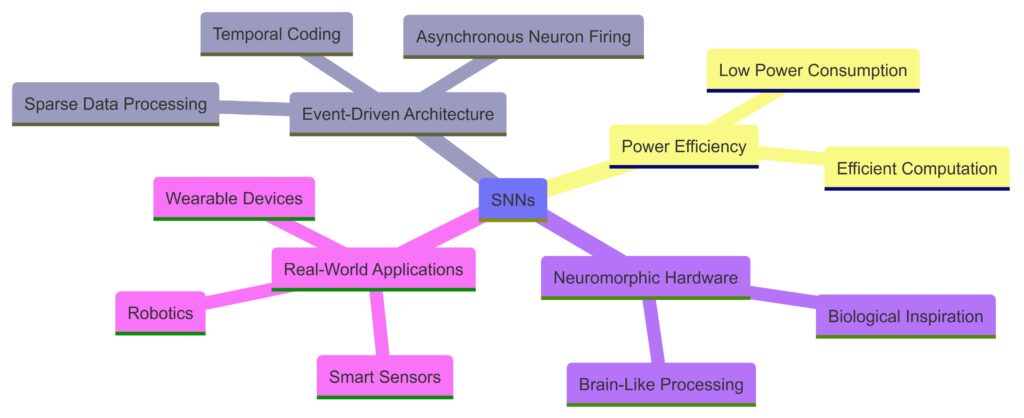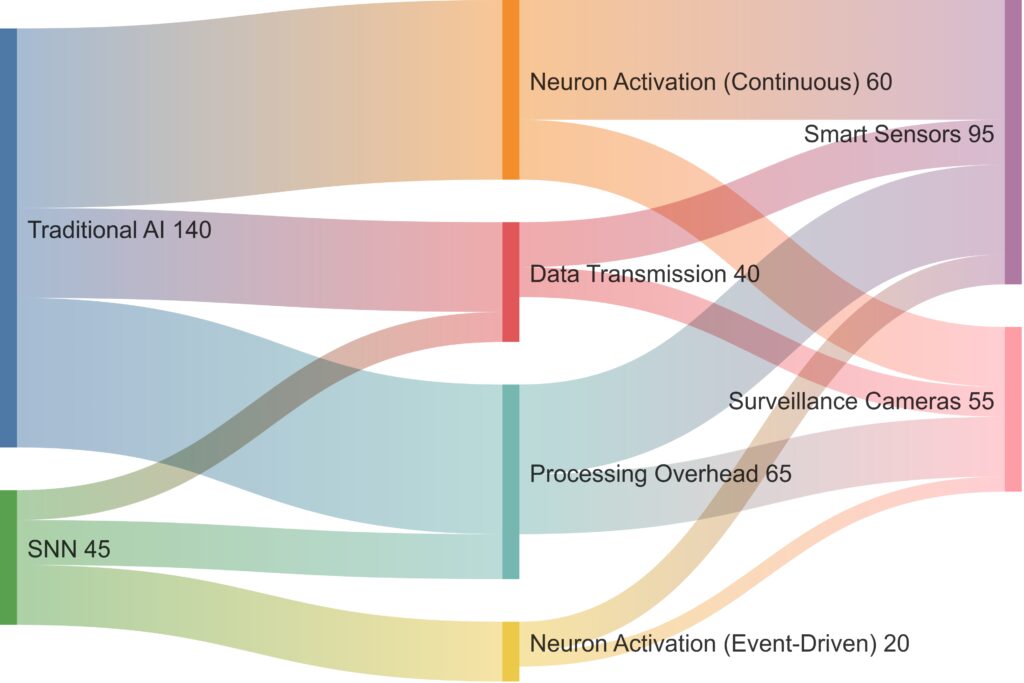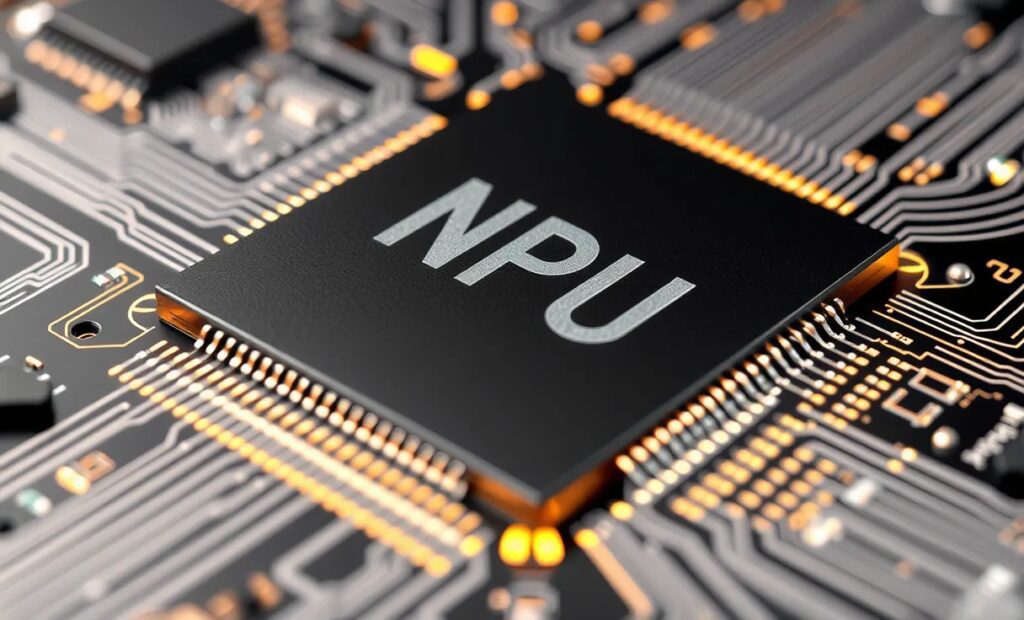
Edge AI is transforming how we process data and make decisions on-the-fly. As Internet of Things (IoT) devices proliferate, the demand for low-power, efficient solutions continues to grow.
One such promising innovation is Spiking Neural Networks (SNNs). These biologically inspired networks are set to revolutionize how we achieve intelligent decision-making on low-power devices. But how exactly do they work? And why are they critical for the future of edge AI?
In this article, we’ll explore the fundamentals of Spiking Neural Networks and how they’re helping IoT devices bring AI closer to the edge.
What Are Spiking Neural Networks?
How Spiking Neural Networks Work
Unlike traditional artificial neural networks (ANNs), SNNs operate on the principle of spikes—discrete events in time, much like the way neurons in the human brain function. Instead of processing continuous signals, they transmit information through electrical impulses (or “spikes”). This allows them to only react when necessary, making them more power-efficient than standard neural networks.
This event-driven nature means that SNNs can remain dormant until they need to respond to a stimulus, thus saving energy, which is vital for IoT devices with limited resources.

Biological Inspiration
SNNs are based on neuromorphic computing principles, meaning they mimic the human brain’s biological processes. Neurons in SNNs only activate when they receive sufficient input, sending a spike through the network. This concept allows these networks to learn and adapt in a more brain-like manner compared to conventional deep learning approaches.
For instance, just as our brain doesn’t react to every piece of information, an SNN only responds when the incoming signal surpasses a certain threshold. This threshold-driven mechanism offers tremendous energy savings.
Why SNNs Over Traditional AI Models?
The main advantage of SNNs is their power efficiency. For IoT devices, which often run on batteries or have constrained energy sources, the ability to conserve power while still processing complex data is crucial. SNNs consume less power because they are sparse in activation—meaning neurons are mostly inactive unless triggered by significant stimuli.
This makes SNNs particularly useful in real-time applications where continuous monitoring is required but energy consumption must be minimized.
The Role of Spiking Neural Networks in Edge AI

Edge AI and IoT: A Perfect Match
Edge AI refers to performing artificial intelligence computations locally on a device rather than sending the data to a centralized server. By bringing AI closer to where data is collected, edge AI significantly reduces latency, saves bandwidth, and improves data privacy.
For example, think about smart home devices that can detect motion or a health monitoring device that keeps track of vital signs. These devices need to be smart, but also lightweight in terms of power consumption. This is where SNNs come in, providing a low-power alternative to standard AI algorithms that often require intensive computational resources.
SNNs in Real-World IoT Applications
- Smart Sensors: SNNs are being used in low-power sensors that can detect environmental changes, like temperature, light, or sound. For instance, a sound sensor using an SNN could remain inactive until it detects a specific frequency or noise level, then trigger the necessary action.
- Energy-Efficient Surveillance: In security cameras, SNNs help by allowing the camera to only become fully operational when movement is detected, thus saving battery life when the environment is still.
- Wearable Devices: Fitness trackers or health monitors powered by SNNs can monitor activities or vital signs without constantly draining battery life, only activating when necessary. This is especially important for medical devices that must run for long periods without frequent charging.
Reducing Latency with SNNs
Another major advantage of SNNs is their ability to reduce latency. Since SNNs can process and react to data locally (on the edge), there is no need to send data to a cloud for processing, significantly reducing the time it takes to get results. This is essential for time-critical applications like autonomous vehicles or real-time monitoring systems.

Challenges and Future of SNNs for Edge AI
Hardware Limitations
One of the major challenges in deploying SNNs is the need for specialized neuromorphic hardware. Traditional CPUs and GPUs are not designed to handle the spike-based computation efficiently. However, companies like Intel and IBM are making significant strides in developing hardware specifically built for SNNs, such as Intel’s Loihi chip.
These chips mimic brain-like operations and are optimized for the sparse, event-driven nature of SNNs, providing a solution for hardware bottlenecks that have historically limited their widespread adoption.
Timeline for SNN Hardware Development

Training Complexity
Another challenge lies in the training of SNNs. Unlike conventional neural networks that can be trained using backpropagation, training SNNs is more complex due to their spike-based nature. Researchers are developing new methods, such as spike-timing-dependent plasticity (STDP), which allows SNNs to learn in a manner similar to the brain’s synaptic learning process.
The Road Ahead
While there are challenges, the future of SNNs in edge AI looks promising. With advancements in neuromorphic hardware and more efficient training methods, SNNs will likely play a significant role in pushing AI capabilities further into the edge. As more IoT devices are deployed across industries, the demand for low-power, real-time AI will only grow, making SNNs a critical piece of the puzzle.
Conclusion: The Power of SNNs for IoT and Edge AI
Spiking Neural Networks offer an exciting opportunity for edge AI applications, especially in the world of IoT where power and efficiency are paramount. By mimicking the brain’s efficient, event-driven behavior, SNNs provide a path towards smarter, more energy-conscious devices. Whether it’s in wearable tech, smart homes, or industrial sensors, the potential for spiking neural networks to drive the next wave of IoT innovation is enormous.
Power Efficiency in Edge AI vs Traditional AI

As research continues to unlock their full capabilities, we can expect to see more devices adopting SNNs, bringing low-power intelligence to the edge, and shaping the future of IoT.
Further Reading:
- Neuromorphic Computing at Human Scale – Intel’s exploration of reconfigurable hardware to model human-scale neuromorphic computing, including their work on the Loihi research chipIntelIntel Download Center.
- Taking Neuromorphic Computing to the Next Level with Loihi 2 – A detailed look at Intel’s Loihi 2 chip, which pushes the boundaries of energy efficiency and event-driven AI processingIntel Community.
- Exploring Neuromorphic Computing for AI: Why Spikes? – An engaging discussion on why spikes (discrete events) are critical for efficient neural computing and how Intel’s research is advancing this fieldIntel.
FAQs
Why are SNNs important for edge AI?
SNNs are crucial for edge AI because they allow for real-time data processing with minimal power consumption. Edge AI typically runs on devices with limited resources, such as sensors, smart cameras, or wearable tech. The low-power nature of SNNs, combined with their ability to process data locally, helps reduce latency and energy use, making them ideal for these environments.
How do SNNs differ from traditional neural networks?
Traditional neural networks (ANNs) rely on continuous signal processing and usually consume a significant amount of power for operations like deep learning. In contrast, SNNs function based on spikes—discrete events that trigger only when specific input conditions are met. This reduces unnecessary activation, leading to sparse data processing, which is why SNNs are more power-efficient and suited for devices with limited energy resources.
What are some real-world applications of SNNs?
SNNs are used in a variety of low-power IoT applications:
- Smart sensors for environmental monitoring, where the system only activates in response to changes like sound or temperature.
- Energy-efficient surveillance systems, where cameras remain dormant until movement is detected, saving power.
- Wearable health devices that monitor vital signs, activating only when anomalies are detected, helping prolong battery life.

What are the challenges of implementing SNNs?
One of the main challenges is the lack of suitable hardware for efficiently running SNNs. Unlike ANNs that can run on standard CPUs or GPUs, SNNs require neuromorphic hardware—specialized chips designed to handle spike-based computations. Companies like Intel are developing neuromorphic processors, such as the Loihi chip, but these are still in early stages of development.
Another challenge is the complexity of training SNNs. Traditional training methods like backpropagation don’t work as well with SNNs because of their event-driven nature. Researchers are exploring alternative learning methods, such as spike-timing-dependent plasticity (STDP), which simulates how neurons in the brain learn based on timing.
How do SNNs help reduce latency in IoT devices?
Because SNNs can process data locally on devices without needing to send information to a centralized cloud, they significantly reduce latency. This real-time processing is critical for autonomous systems like robots or drones, where rapid decision-making is essential. By handling data at the edge, SNNs ensure faster responses while consuming minimal energy.
How do Spiking Neural Networks contribute to energy efficiency?
SNNs achieve significant energy efficiency by operating in an event-driven manner. Unlike traditional neural networks that continuously process all inputs, SNNs only activate neurons when a stimulus crosses a threshold. This leads to fewer operations, less heat generation, and lower power consumption, which is especially valuable for IoT devices that often run on batteries or have limited power supplies. Neuromorphic chips like Intel’s Loihi have demonstrated up to a 10x improvement in energy efficiency over conventional architectures when running AI models
What is neuromorphic hardware, and why is it important for SNNs?
Neuromorphic hardware is specifically designed to mimic the way biological brains process information. These chips are built to handle spike-based computations, allowing SNNs to function more efficiently compared to running on traditional processors. Neuromorphic chips like Intel’s Loihi 2 are optimized for parallel processing, low latency, and low power consumption. This hardware plays a critical role in scaling the performance of SNNs for real-time AI applications like robotics, smart cameras, and health monitoring
How are SNNs trained?
Training SNNs is more complex than traditional neural networks due to their discrete, event-driven nature. Conventional backpropagation techniques don’t work well with SNNs, leading researchers to develop new methods like spike-timing-dependent plasticity (STDP). STDP allows SNNs to learn based on the precise timing of spikes, mimicking how neurons in the brain strengthen connections based on usage. Other advanced methods include surrogate gradient descent, which modifies gradients for use in spiking models. These training techniques are still evolving, but they hold promise for improving SNNs’ adaptability
Can SNNs be used in autonomous systems?
Yes, SNNs are particularly well-suited for autonomous systems due to their low power consumption and real-time processing capabilities. For example, in autonomous vehicles or drones, where quick decision-making is essential, SNNs can help process sensor data on the fly without the need for cloud-based processing. By reducing latency and power consumption, SNNs can enable these systems to operate for longer periods while maintaining high responsiveness
What are the main industries adopting SNNs and neuromorphic computing?
Industries that require low-power, real-time AI are beginning to adopt SNNs and neuromorphic computing. These include:
- Healthcare, where SNN-powered wearables can monitor vital signs with minimal energy usage.
- Smart cities, where low-power sensors help monitor environmental data or traffic patterns.
- Security and surveillance, where cameras using SNNs can remain inactive until detecting movement, conserving energy IntelIntel Download Center.
What is the future of SNNs in AI?
The future of SNNs in AI looks promising as advancements in neuromorphic hardware and new training techniques continue to evolve. As edge AI grows in importance across industries, the demand for energy-efficient, real-time data processing will rise, positioning SNNs as a key player. Researchers and companies are actively working on scalable solutions that could bring SNNs to mainstream applications.





